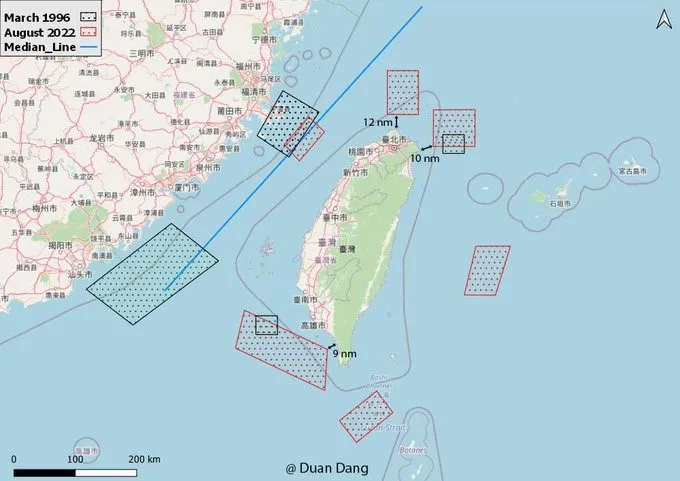
Following the United States (US) Congress Speaker Nancy Pelosi’s visit to Taipei, an angered People’s Republic of China (PRC) is undertaking provocative military manoeuvres in the Taiwan Strait. Pelosi had arrived in Taipei last Tuesday, disregarding a blizzard of warnings and intimidatory signals from the PRC, which considers Taiwan a renegade province. Post landing in Taiwan, Pelosi tweeted reiterating the US’s unflinching commitment to support Taiwan’s vibrant democracy and reaffirming American support to ‘shared interests including advancing a free and open Indo-Pacific region,’ further irking the already agitated Beijing.
In a departure from the past, the PRC has conducted exercises that are near the main island of Taiwan. There are four areas where Chinese forces have mounted pressure on the Taiwanese, which include;
1) Several joint military operations around the Taiwanese main island.
2) Joint air and sea exercises in the surrounding vicinity of the Northern, South Western, and South Eastern Taiwan islands.
3) Live ammunition fire at extended ranges.
4) Missiles tipped with conventional warheads have been test-fired.
Post landing in Taiwan, Pelosi tweeted reiterating the US’s unflinching commitment to support Taiwan’s vibrant democracy and reaffirming American support to ‘shared interests including advancing a free and open Indo-Pacific region,’ further irking the already agitated Beijing.
Chinese aircraft and naval vessels crossed the median line that divides the main island of Taiwan from the Chinese mainland, conducting drills that would involve an encircling attack against Taiwan—potentially constituting preparation for a full-scale invasion.
1995–1996 Taiwan Strait Crisis
The current exercises are in sharp contrast to the last major Taiwan Strait Crisis in 1995-96, which was more circumscribed despite also having featured several military drills. The PLA had then established a centralised headquarters (HQ) in Beijing for operations targeting Taiwan. The responsibility of the HQ was to coordinate and direct exercises by the various service arms of the PLA and including the erstwhile military regions of Nanjing and Guangzhou. However, the PRC went to great lengths to avoid direct confrontation with Taiwan, and live fire exercises and wargames were conducted at a considerable distance from the main island of Taiwan.
Figure-1
Two overlaying Maps Showing Contrast Between Taiwan Straits Crisis–1995-96 and the current Taiwan Straits Crisis – August 4-7, 2022
 Source: Duan Dang
Source: Duan Dang
Although missile firing tests conducted in 1995–96 represented a provocation, they were designed to avoid escalation. During that crisis, the US’s response weighed heavily on Beijing to the point that the Chinese sent then Vice Foreign Minister Liu Huaqiu to Washington in early March 1996 to convey that it had no desire to invade Taiwan, but only to conduct military exercises which would deter Taipei from declaring independence.
The responsibility of the HQ was to coordinate and direct exercises by the various service arms of the PLA and including the erstwhile military regions of Nanjing and Guangzhou.
The American response in early 1996 was robust, in contrast to Washington’s decidedly ambiguous response in the initial phases of the crisis in late 1995 which conveyed to Beijing that Washington’s resolve was weak. The emboldened Chinese had pushed ahead with more provocative missile tests in early 1996, only to be taken aback by Washington’s subsequent deployment of two carrier groups, which Beijing clearly saw and labelled an overreaction.
In 1996, Beijing knew it would lose a war with the US if it pressed ahead with an invasion, and was consequently deterred from further brinksmanship. The current scenario is quite different. With the US–China military balance less asymmetric, it is Washington that is now labelling the Chinese response to Pelosi’s visit as an overreaction.
China’s advantages
In the current crisis, China has two aircraft carriers, new missiles, and the world’s largest navy. The PRC has introduced dozens of fighter jets and force-multiplier aircraft, intended to overwhelm the F-16s of Taiwan as well as American aircraft operating in the region. In the mid-1990s crisis, Beijing neither had the air nor amphibious assault capabilities that it now possesses for a cross-strait invasion.
Over the last decade, the PLA has made considerable advances in the development and acquisition of rotary-wing aircraft and regardless of how the current crisis ends, its capabilities in this area are set to grow over the next decade. Rotary-wing aircraft are geared for air assault operations and the People’s Liberation Army has fielded several of them as well as trained many personnel to operate them.
Beijing has also undertaken saturation attack exercises as part of the current drills in a quest to overwhelm Taiwanese air defences.
China’s fixed-wing aircraft fleet has also seen considerable improvement over the last decade and has been involved in significant numbers during the drills. Although Chinese proficiency in air assault missions is still evolving, Taipei has much to worry about as even the mainland’s current capabilities pose a formidable challenge. Beijing has also undertaken saturation attack exercises as part of the current drills in a quest to overwhelm Taiwanese air defences. Indeed, air assault capabilities enabling precision strikes, including suppression of enemy air defences, could be the strength Beijing needs critically if it is to successfully prosecute an invasion of Taiwan without significant costs and casualties.
Conclusion
To conclude, the current drills, in which Beijing has mobilised an unprecedented amount of military muscle, are geared toward testing its own capabilities without actually fighting a war. The drills are also designed to ascertain the nature of Taiwan’s response. The activation of Taiwanese missile defence capabilities, in response to the drills, is likely to provide military planners in Beijing with a glimpse of how to neutralise Taiwan’s missile defence radars and troop concentrations, as well as deployment patterns of the island territory’s forces. Unlike the Taiwan Strait crisis of 1995–96, which featured missile tests and coordination between various branches of the PLA over several months, the latest exercise has taken place on compressed timelines and is the closest the PLA could have come to experience the complexities of real battlefield conditions. It would likely prepare the PLA better for actual war in the not-too-distant future.
The views expressed above belong to the author(s). ORF research and analyses now available on Telegram! Click here to access our curated content — blogs, longforms and interviews.



 Following the United States (US) Congress Speaker Nancy Pelosi’s visit to Taipei, an angered People’s Republic of China (PRC) is undertaking provocative military manoeuvres in the Taiwan Strait. Pelosi had arrived in Taipei last Tuesday, disregarding a blizzard of warnings and intimidatory signals from the PRC, which considers Taiwan a renegade province. Post landing in Taiwan, Pelosi tweeted reiterating the US’s unflinching commitment to support Taiwan’s vibrant democracy and reaffirming American support to ‘shared interests including advancing a free and open Indo-Pacific region,’ further irking the already agitated Beijing.
In a departure from the past, the PRC has conducted exercises that are near the main island of Taiwan. There are four areas where Chinese forces have mounted pressure on the Taiwanese, which include;
1) Several joint military operations around the Taiwanese main island.
2) Joint air and sea exercises in the surrounding vicinity of the Northern, South Western, and South Eastern Taiwan islands.
3) Live ammunition fire at extended ranges.
4) Missiles tipped with conventional warheads have been test-fired.
Following the United States (US) Congress Speaker Nancy Pelosi’s visit to Taipei, an angered People’s Republic of China (PRC) is undertaking provocative military manoeuvres in the Taiwan Strait. Pelosi had arrived in Taipei last Tuesday, disregarding a blizzard of warnings and intimidatory signals from the PRC, which considers Taiwan a renegade province. Post landing in Taiwan, Pelosi tweeted reiterating the US’s unflinching commitment to support Taiwan’s vibrant democracy and reaffirming American support to ‘shared interests including advancing a free and open Indo-Pacific region,’ further irking the already agitated Beijing.
In a departure from the past, the PRC has conducted exercises that are near the main island of Taiwan. There are four areas where Chinese forces have mounted pressure on the Taiwanese, which include;
1) Several joint military operations around the Taiwanese main island.
2) Joint air and sea exercises in the surrounding vicinity of the Northern, South Western, and South Eastern Taiwan islands.
3) Live ammunition fire at extended ranges.
4) Missiles tipped with conventional warheads have been test-fired.

 PREV
PREV



